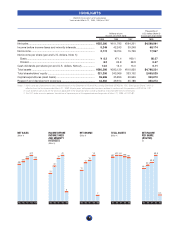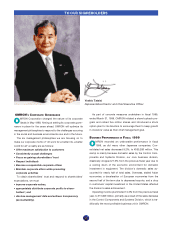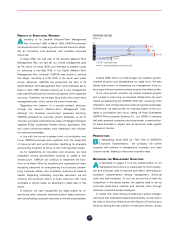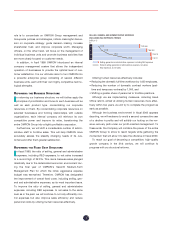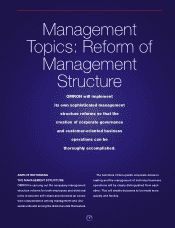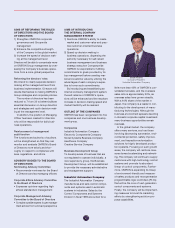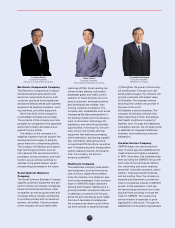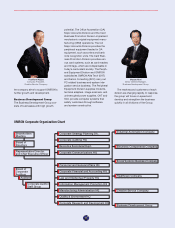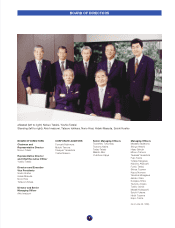Omron 1999 Annual Report Download - page 5
Download and view the complete annual report
Please find page 5 of the 1999 Omron annual report below. You can navigate through the pages in the report by either clicking on the pages listed below, or by using the keyword search tool below to find specific information within the annual report.
RESULTS OF STRUCTURAL REFORMS
According to its Seventh Medium-Term Management
Plan, from April 1996 to March 1999, OMRON promoted
structural reforms to create a growth-oriented structure, estab-
lish an innovative cost structure, and revitalize corporate
resources.
In fiscal 1999, the final year of the Seventh Medium-Term
Management Plan, we had set our overall management goal
as 7% return on equity (ROE) and intended to prepare a plan
for achieving a two-digit ROE in the Eighth Medium-Term
Management Plan. However, OMRON was unable to achieve
this target, recording a 0.7% ROE in the fiscal year under
review. Moreover, OMRON has postponed the start of its
Eighth Medium-Term Management Plan, which had been set to
begin in April 1999, because drawing up a new management
plan was difficult amid the uncertain prospects of the Japanese
economy. Therefore, we will start fiscal 2000 with a short-term
management plan, which covers the current fiscal year.
Regarding the creation of a growth-oriented structure,
through the Seventh Medium-Term Management Plan,
although the business environment appeared daunting,
OMRON executed its corporate growth strategies—a set of
visionary concepts comprising the areas of intelligent transport
systems (ITSs); multimedia-oriented factory automation (FA);
and cyber-community-related, total healthcare, and informa-
tion sensing businesses.
In line with the current business trend of prioritization and
focus, OMRON reviewed each operation from the viewpoints
of future growth and profit potential, identifying its strengths
and working to tighten its focus on the most important issues.
As for establishing an innovative cost structure, we have
integrated various administrative systems to create a new
infrastructure. OMRON will continue to streamline the func-
tions of its Head Office by simplifying its organizational roles,
relocating personnel for strengthening line functions, stream-
lining business offices, and constantly reviewing its balance
sheets. Regarding revitalizing corporate resources, we will
continue the structural reform of fixed costs but with more
emphasis in certain areas, as described in detail later in this
report.
In addition, we have reorganized our sales system by re-
structuring sales channels, reinforcing direct sales promotion,
and concentrating corporate resources on the sensing business.
In fiscal 1999, within our initial budget, we created a growth-
oriented structure and strengthened our sales force. We also
placed high priority on sharpening our management focus on
securing profits and reviewing major projects that affect profits.
To be more growth oriented, we revised business projects
and worked on improving our business infrastructure (by such
means as suspending the OMRON Total Fair, reviewing office
integration, and cutting personnel costs and general expenses).
Furthermore, we restructured our business based on the con-
cepts of prioritization and focus, selling off three businesses:
OMRON Microcomputer Systems Co., Ltd. (OMS), a company
that sells personal computers and peripherals; a semiconduc-
tor sales business in Japan; and an electronic cash register
business in Europe.
PERSPECTIVES
By designating fiscal 2000 as “Year One of OMRON’s
Corporate Transformation,” the Company will further
progress with reforms in management, business, and fixed
cost structures, leading to improved corporate value.
REFORMING THE MANAGEMENT STRUCTURE
As described on pages 5 to 8, the transformation of our
management structure is a prerequisite for both employ-
ees and divisional units to become self-reliant, eliminating an
excessive codependence among management, divisional
units, and staff members. To not only survive but to beat the
competition in the global market, we urgently need to set up
corporate governance systems and execute them through
customer-oriented business strategies.
To realize this, while aiming at achieving a simple manage-
ment style that emphasizes speed and flexibility, we will reform
the roles of individual directors and the Board of Directors as a
whole by adding the new position of executive director, whose
3
39,239
40,905
46,032
11,849
OPERATING INCOME
(Million ¥)
’96
’97
’98
’99
FY
Operating income
Ratio of operating income to net sales
7.5
6.9
7.5
2.1



